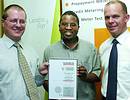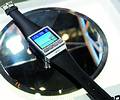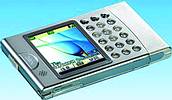
Southern Africa
Altech subsidiary, Alcom Systems, has been awarded the South African Police Service tender for the supply, delivery, installation, commissioning and testing of a complete digital terrestrial trunked radio (TETRA) communications network system for Gauteng. The contract, said to be the largest radio communications contract ever awarded on the African continent, is valued in excess of R500m and will be allocated over the three year period of the roll-out. Alcom Systems was recently re-named Alcom Matomo.
Landis+Gyr was recently awarded the ISO 9001:2000 standard by the South African Bureau of Standards. The event was hosted by Keith Lennox, CEO of Landis+Gyr South Africa, and dignitaries attending included Andreas Umbach, CEO and President of Landis+Gyr worldwide, as well as Oupa Fokazi and Jimmy O'Kennedy of Eskom, one of Landis+Gyr's largest customers in Africa. The presentation to Landis+Gyr was made by Monde Tyusha and Eddie Vermaak of the Global Conformity Services Division of the SABS.

RBF Technology was recently awarded its new listed status for Quality Management to ISO 9001:2000. Picture shows QA manager, Gordon vd Merwe (left) with managing director, Johan Basson.

Overseas
Business
Royal Philips Electronics posted a net profit of 598m Euros in the fourth quarter after a loss of 1,5 bn Euros a year earlier. Sales were up slightly to 9017m Euros with all divisions making positive contributions to income, said the company. After 10 quarters of losses, Philips' semiconductor division was profitable in Q4, supported by increased sales, improved margins, lower R&D spending, and the benefits of earlier restructuring programs. Sales were down on negative currency effects, particularly the weakening dollar, and with currency effects excluded, the company said sales advanced 4% in 2003.
Maxim reported net revenues of $338,1m for fiscal Q2 2004, an 18,2% increase over the $286,1m reported for the Q2 of fiscal 2003 and a 9,0% increase over the $310,2m reported for the Q1 of fiscal 2004. Net income for the quarter was $98,5m, a 27,8% increase over the $77,1m reported last year and a 12,8% increase over the $87,4m for the first quarter. Jack Gifford, CEO of Maxim, said that due to expected demand over the next two quarters, Maxim has accelerated its schedule for production at its newly-acquired fab in San Antonio, Texas, to the first quarter of fiscal 2005 - approximately nine months earlier than originally planned.
On Semiconductor announced that revenues in the fourth quarter of 2003 were $279m, an increase of 5% from the third quarter of 2003 and compared to $2685m in the like period a year ago. During the Q4 of 2003, On reported a net loss of $42m, that included restructuring, asset impairments and other charges of $29,9m and a loss on debt prepayment of $1,3m. During the Q3 of 2003, it reported a net loss of $16m. It lost $39,6m a year ago. Total revenues for 2003 were $1,069 bn, a decrease of 2% from $1,094 bn in 2002. During 2003, the company reported a net loss of $167m.
Companies
Infineon Technologies has signed an agreement to acquire ADMtek, a fabless IC design company based in Hsinchu, Taiwan, for around 80m Euros. Infineon will establish a new company called Infineon-ADMtek that will focus on developing broadband customer premise equipment ICs and enable Infineon to enter the home gateway market.
Finisar is to acquire Honeywell's Texas-based VCSEL Optical Products business, for around $75m in cash. The VCSEL Optical Products business manufactures vertical cavity surface emitting lasers (VCSELs), primarily used in high-speed fibre-optic datacom and position-sensing applications.
Synopsys has signed a definitive agreement to acquire substantially all of the assets of Analog Design Automation (ADA) that will enable it to introduce new and innovative analogue and mixed-signal design technologies. ADA is a leading provider of automated circuit optimisation solutions for analog, mixed-signal and custom ICs.
STMicroelectronics' Assembly Test Services buying US-based chip testing and packaging firm, ChipPAC, in a stock deal worth $1,6 bn. The merger is expected to lead to the formation of the world's second biggest chip testing house.
Broadcom has acquired a portfolio of storage technology patents from Cirrus Logic that that covers many fundamental innovations in the magnetic and optical storage areas.
Nokia is buying Psion's 31,1% stake in mobile software supplier Symbian for an estimated £135,7m, valuing the Psion spin-off company at £436m. This gives Nokia the controlling share of 62,1%. Mobile phone maker Nokia uses the Symbian operating system in many of its products. Other stakeholders include Ericsson, Sony Ericsson, Samsung, Panasonic and Siemens. Nokia has, however, stressed the continued openness of the Symbian software.
Pioneer has announced that it is acquiring NEC's PDP (plasma display panel) business, making Pioneer the world's largest PDP maker with annual capacity of over 1 million units in 2005. Pioneer owns three PDP lines for 43" and 50" panels with a total capacity of 250 000 units a year.
Rhetorical, a UK-based text-to-speech company, has signed a licensing agreement with BBN Technologies, involving the sale of speech-recognition and language-processing technologies. The agreement gives BBN Technologies rights to integrate current and future versions of Rhetorical's text-to-speech technology in BBN's award-winning speech-recognition system called Hark.
Fourteen Japanese companies are launching the Ubiquitous Open Platform Forum whose main goal is to provide generic Internet access for digital consumer electronics and electric home appliances. The forum seeks to provide a corporate-free common platform upon which consumers can more easily access networks. Members of the initiative include telecocarriers, electronics manufacturers and information service providers. The forum will also seek participants from outside Japan.
A group of structured ASIC manufacturers and EDA companies - Chip Express, Lightspeed Semiconductor, Synplicity, and Tera Systems - have formed the 'Structured ASIC Association' (SAA), with the intention to establish structured ASICs as a distinct market segment and educate the industry about the technology. The SAA defines a structured ASIC as 'an integrated circuit architecture that delivers reduced entry cost and faster time to silicon using a predefined arrangement of late-stage mask-customisable logic and pre-diffused macros'. See www.structuredasic.com.
ST Assembly Test Services, based in Singapore, and US-based ChipPAC have announced that they are to merge operations in a stock-swap deal worth $1,6 bn. Its global operations will span China, Korea, Malaysia, Singapore, Taiwan, and the United States. The renamed STATS ChipPAC, headquartered in Singapore, expects to generate $25m to $30m in cost savings. Services will include mixed-signal test, strip test, chip-scale, stacked die, flip-chip, wafer level and system-in-package technologies, and wafer bumping capabilities.
Sumitomo Chemical and Cambridge Display Technology (CDT) have agreed to co-operate in the development of solution-processed polymer light emitting diode (PLED) materials designed for use in flat panel displays. PLED materials are expected to find application in portable equipment and in TV displays and possibly for lighting.
Industry
The semiconductor industry grew 16,2% in 2003 and the market is expected to increase by more than 30% in 2004, according to Advanced Forecasting of California. The group said that should the war with Iraq not have happened, the IC industry would have ended 2003 growing approximately 25%.
iSuppli predicts that the market for flash memory will reach $15,7 bn in 2004, up 39% from its 2003 size of $11,32 bn. The numbers include flash revenues from multichip packages. NAND flash was responsible for $3,83 bn of the total in 2003, while NOR flash scored a value of $7,48 bn. In 2004 the NAND market is expected to grow by 63,9% whereas NOR is expected to grow a still healthy, but less spectacular 25,8% to take the market sizes to $6,28 bn and $9,42 bn, respectively. Samsung was the top flash supplier in 2003, with Spansion, the flash memory joint venture between Advanced Micro Devices and Fujitsu in second place and Toshiba in third.
In 2003, digital cameras in the US outsold film models. Digital camera sales are up 40 to 50% from last year according to recent reports, and are surpassing the sales of film-based cameras in both market share and dollar value. This is according to Research and Markets, a European resource for market research. Global shipments of digital cameras reached 50 million units in 2003 - double the rate of 2002. It estimates that in 2004 the rate of increase will slow, but sales will still reach 65 million.
iSuppli forecasts that the wired communications equipment business will have 7,5% growth this year. However, if the markets for Voice Over Internet Protocol (VOIP) and Fibre to the Premises (FTTP) develop rapidly, growth could be considerably higher, it said. The recovery in the network equipment segment is fuelling improved financial results for PLD suppliers. iSuppli is forecasting two very solid years for PLDs in 2004 and 2005, with 16,3% and 18,5% growth, respectively.
The concept of worldwide academic cooperation has come a step closer following the commencement of regular 'distance education' workshops between the Indian Institute of Science in Bangalore and the Toulouse University Network in France. The primary aim of the FICUS (French-Indian Cyber University) project is to create a cyber-platform devoted to information exchange between India and France within the fields of research, education, transfer of technology and the dissemination of knowledge on a long-term non-commercial basis. Key to the project is the provision of ad hoc satellite connections (DVB/MPEG2 duplex links) between the two universities, using the Europe*Star 1 satellite.
Rambus announced that the Technical Board of Appeals of the European Patent Office (EPO) has made a ruling revoking Rambus' European patent relating to a technology called 'an access time register.' Rambus said the ruling was a small part of a larger picture.
Staktek Group and Infineon Technologies have reached an out-of-court settlement of a patent and trade secret suit related to leaded package stacking technologies. The two have agreed to release all claims made against the other in the litigation. Additionally, Staktek has granted Infineon a licence to its intellectual properties (IP) at issue in the suit and to other patents in Staktek's leaded package stacking patent portfolio.
Infineon Technologies is expanding its Memory Development Center at its Dresden location, with the aim of further strengthening and extending the central role of the site in the development of process technology, particularly for DRAM and flash products.
Technology
Intel researchers have announced that using silicon photonics, they have reached 1 GHz speeds with modulators that have on-chip phase-shifting capabilities. Traditionally, optical components are typically made using indium phosphide, lithium niobate and gallium arsenide, which allow faster speeds but are more costly. Previously the record for a silicon modulator had been 20 MHz. Intel's 50-times-faster speeds are achieved using a different approach - MOS capacitor structures that accumulate majority carriers to modify the refractive index of light. It splits a laser lightbeam into two paths, of which their phases can be shifted by applying a voltage. The 1's and 0's digital data is then represented as the phase of two light beams, which are either summed (two beams of same phase) or subtracted (each beam in a different phase).
Scientists at Philips Research have announced that they have made MEMS (micro-electromechanical system) capacitors that could be used to enhance performance and reduce the size of RF circuits in mobile phones. The microscopic equivalent of air-spaced variable/switchable capacitors, the MEMS devices can be integrated into silicon chips by conventional wafer fabrication processes. By under-etching an area of the silicon chip's top metal layer, a microscopic metal beam is created that moves up and down through electrostatic attraction in response to an applied voltage. Small deflections of the beam result in a continuously variable capacitance-versus-voltage characteristic. Philips Research claims to have achieved a ratio between maximum and minimum capacitance as high as 17, and Q-factors as high as 500, outperforming virtually all other types so far reported.
Intel demonstrated its own ultrawideband chip as part of a so-called wireless USB initiative at the Intel Developer Forum. Intel unveiled a multicompany initiative to support a 480 Mbps wireless USB technology over 10 metres based on UWB. The USB initiative and the Intel chip will be based on the multiband OFDM technology.
A 'TV Wrist Watch' that uses Sony's new stamp-sized TV Tuner chip-set (BTD-ZJ611) was displayed at CEATEC 2003 in Japan by its manufacturer, NHJ. The watch features a 38 mm TFT LCD colour display and measures 45 x 48 x 18 mm. The front includes a monochrome panel for displaying time. Built-in battery gives operating time of around two hours, and the headphone cable doubles as an antenna.

NEC has manufactured the world's smallest and slimmest mobile phone The card-shaped, camera-equipped GSM mobile phone will be launched in China this month. The GSM/GPRS camera-phone measures 85 by 54 mm by 8,6 mm deep and weighs 70 g. It has a 46 mm TFT colour display with 120 by 160 pixel resolution and a digital camera with 300 000 pixels. Two major design challenges were developing thin sheet-like elements that could be stacked and providing a stiff and protective outer case.


© Technews Publishing (Pty) Ltd | All Rights Reserved